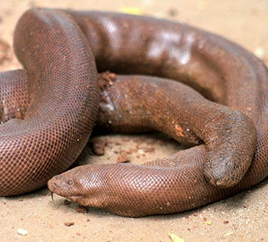

31st August 2023 (9 Topics)
Context
A report by the Wildlife Conservation Society (WCS)-India has pointed out around 172 incidents of seizures of red sand boa (Eryx johnii) between the years 2016-2021.
Highlights of the Report:
- Published by: The Counter Wildlife Trafficking unit of WCS-India.
- Title: ‘Illegal Trade of Red Sand Boa in India 2016-2021 ‘
- It collates information from media reports on the seizures.
- Around 172 unique media records involving illegal sand boa trade has been searched from January 2016 to December 2021 in India.
- Fifteen of these included sand boas alongside other wildlife species, with 157 records talking only about sand boa species.
- One hundred and twenty-one of the 157 incidents documented seizures involving red sand boas.
- Aim: This is an attempt to bring to light the trade in red sand boas, especially online trade, and to develop a better understanding that might help prevent the illegal collection and sale of the species.
- Key data:
- The highest number was recorded in Maharashtra (59), often from urban areas such as the districts of Pune (11), Thane (nine), Raigad (seven), and Mumbai Suburban (five).
- The second highest number was recorded from Uttar Pradesh (33), often from regions in proximity to the international border with Nepal, such as the districts of Bahraich (eight) and Lakhimpur-Kheri (seven).
|
Red sand boa is now acknowledged as one of the most traded reptile species in the illegal trade market, due to its demand in the pet trade, as well as for use in black magic. |
- The study also highlights the role of social media in the illegal trade of the species.
- YouTube serves as a buyer-seller-interface for red sand boas in India, and sometimes acts as a gateway to facilitate trade via
Suggestions from the report:
- The report also suggested that local and international conservation organisations should conduct formative research to better understand the situation of the illegal reptile trade and demand, particularly in Maharashtra and Uttar Pradesh.
- Civil society, education, and conservation organizations should develop training programs to increase the capacity of journalism students.
- There should also be investigative journalists to produce well-researched and impactful media stories on the illegal wildlife trade to reduce misinformation on wildlife consumption and improve awareness of this issue.
About the Species:
- It is a rare non-poisonous snake that is used for making certain medicines, cosmetics and in black magic, and is in huge demand in the international market.
- It is found in whole of India excluding North-east states after North-Bengal.
- Among layman it is famous as "Two-headed Snake" due to the presence of very thick tail having rounded end.
- The trade and possession of the red sand boa is an offence under the Wildlife Protection Act 1972.
- Protection status:
- The species is listed under Schedule 4 of the Act. Also, it is listed in CITES Appendix II.
- The Red sand boa is classified as ‘Near Threatened’ by the International Union for Conservation of Nature (IUCN).


